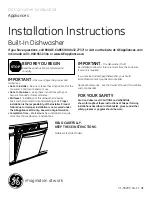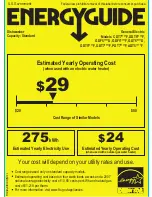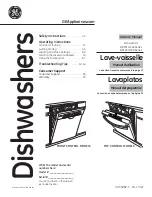
12
Installation and Operation
sufficient for daily use.
• Turn on the water tap.
•
Turn switch 0-1 1 to position 1 (pressed). The operation is signalled by the switch indicator lighting up or
by the indicator with the symbol A. The machine will automatically fill the tub with water; then the heating
phase begins. Indicator C comes on when the water temperature is reached.
•
Insert the rack filled with dishes to wash. The plates must be correctly placed in the rack.
•
On machines with selector 4 select the wash cycle required.
•
To begin the wash cycle, if there is no automatic option, put the liquid detergent in the tub and press the
START button 2. The button light or indicator B will come on, indicating that the cycle has started. At the
end of the washing cycle, a hot rinse cycle will take place. The indicator light of the START button 2 will turn
off when the cycle has finished.
• The appliance is now ready for a new wash.
• At the end of the day, clean the machine.
•
Turn off the machine and the water tap.
DISHES AND CUTLERY LOADING
Before loading the dishes it is necessary to carry out a proper cleaning off of the food residuals. It is not
necessary to rinse the dishes with water before the loading.
WARNING: do not wash items contaminated by petrol, paint, pieces of steel or iron, ash, sand, wax,
lubricating grease. These substances damage the machine. Do not wash fragile items or made of
material that do not stand the washing process.
FOLLOW THESE TIPS:
•
Crockery and cutlery must not lie inside one another, covering each other.
•
Place the dishes so that all the surfaces can be reached by the water; otherwise the dishes cannot be
washed properly.
•
Make sure that the dishes are placed in a stable position and that the empty containers (cups, glasses,
bowls, etc.) do not turn upside down.
•
Place all the empty containers like cups, glasses, etc., upside down.
•
Place in tilted position the dishes with deep hollows, so that the water can drain.
• Make sure that the smaller dishes do not fall from the baskets.
•
Check all the wash arms runs freely and they are not blocked by too tall or too prominent crockery.
Eventually, run a manual rotation of the arms to check it.
Some foods, such as carrots, tomatoes, and others, may contain some natural dyes substances, that in large
amounts, can alter the crockery and plastic parts colors. Any discoloration does not mean that the plastic is not
heat resistant.
CROCKERY AND CUTLERY NOT SUITABLE FOR DISHWASHER
•
Wooden crockery and cutlery or with wooden parts; water at high temperature causes deformation to wood.
Also the adhesives used are not suitable for treatment in the dishwasher; a consequence could be the
handles detachment.
•
Crafts, precious vases or decorated glasses.
•
Not heat-resistant plastic crockery.
Summary of Contents for CD-IT-50-2
Page 18: ...18 Figure Drawings...
Page 19: ...19 Parts Breakdown Model CD IT 50 2 49126 General Body...
Page 20: ...20 Parts Breakdown Model CD IT 50 2 49126 Door...
Page 21: ...21 Parts Breakdown Model CD IT 50 2 49126 Control Panel and Switches...
Page 22: ...22 Parts Breakdown Model CD IT 50 2 49126 Electric Control Components...
Page 23: ...23 Parts Breakdown Model CD IT 50 2 49126 Solenoid Valve Group...
Page 24: ...24 Parts Breakdown Model CD IT 50 2 49126 DVGW Valve...
Page 25: ...25 Parts Breakdown Model CD IT 50 2 49126 Rinse Aid Dispenser Group...
Page 26: ...26 Parts Breakdown Model CD IT 50 2 49126 Boiler Group...
Page 27: ...27 Parts Breakdown Model CD IT 50 2 49126 3 Ways Connection 1...
Page 28: ...28 Parts Breakdown Model CD IT 50 2 49126 3 Ways Connection 2...
Page 29: ...29 Parts Breakdown Model CD IT 50 2 49126 Wash Pump Group...
Page 30: ...30 Parts Breakdown Model CD IT 50 2 49126 Drain Pump Group...
Page 31: ...31 Parts Breakdown Model CD IT 50 2 49126 Pressure Switch Group...
Page 32: ...32 Parts Breakdown Model CD IT 50 2 49126 Wash Arm Group...
Page 33: ...33 Parts Breakdown Model CD IT 50 2 49126 Baskets...
Page 38: ...38 Electrical Schematics Model CD IT 50 2 49126...













































